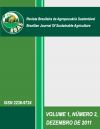USE OF WASTE BARK AND SHAVINGS OF CASSAVA IN RUMINANT FEEDING
DOI:
https://doi.org/10.21206/rbas.v1i2.40Abstract
Cassava (Manihot esculenta Crantz) is considered the most Brazilian of all economic plants and is one of the main food sources for millions, especially in developing countries, where it is grown in small areas with low technological level. Like any industrial process, the manufacture of derivatives of cassava also generates wastes such as bark, and bark and shavings. Cassava producers can take advantage of these residues as feed in the treatment of ruminant animals waste and lowering production costs. Thus, this study aimed to characterize waste bark, bark and cassava through bromatological analysis and guide for producers to use it correctly. The results showed that the bark, bark and cassava can provide energy for the cattle, however, serve as sources of protein and therefore should serve as a food supplement plus other sources of protein.Downloads
Download data is not yet available.
Downloads
Published
2011-12-01
How to Cite
Marcelo Silva Ferreira1, & José Reinaldo Bastos da Silva. (2011). USE OF WASTE BARK AND SHAVINGS OF CASSAVA IN RUMINANT FEEDING . Brazilian Journal of Sustainable Agriculture, 1(2). https://doi.org/10.21206/rbas.v1i2.40
Issue
Section
Artigos
License
1. Proposta de Política para Periódicos de Acesso Livre
Autores que publicam nesta revista concordam com os seguintes termos:
Autores mantém os direitos autorais e concedem à revista o direito de primeira publicação, com o trabalho simultaneamente licenciado sob a Licença Creative Commons Attribution que permite o compartilhamento do trabalho com reconhecimento da autoria e publicação inicial nesta revista.












